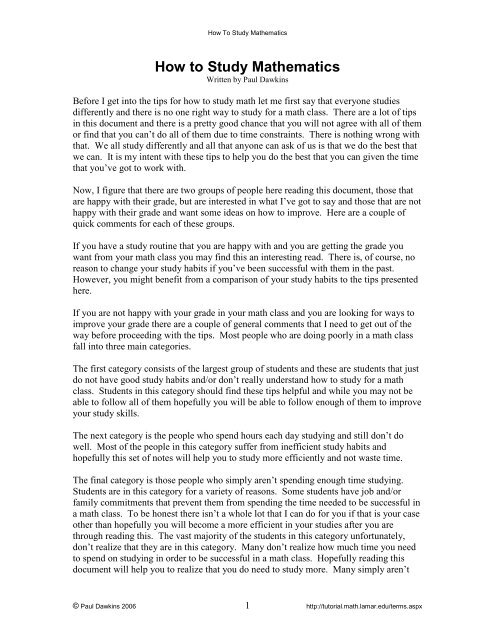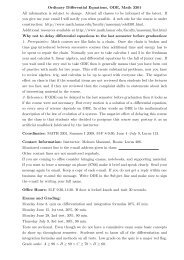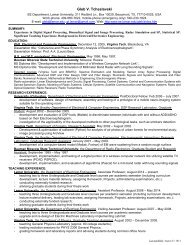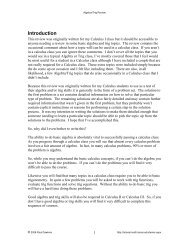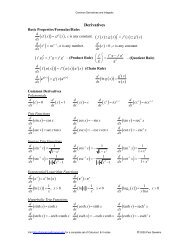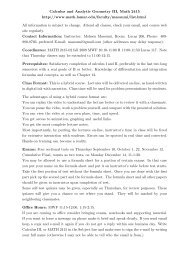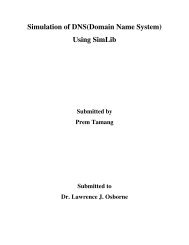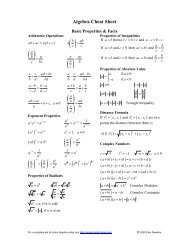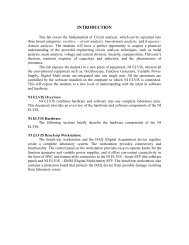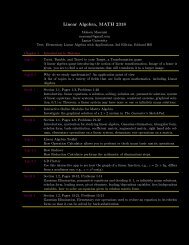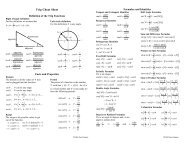How to Study Mathematics - Pauls Online Math Notes - Lamar ...
How to Study Mathematics - Pauls Online Math Notes - Lamar ...
How to Study Mathematics - Pauls Online Math Notes - Lamar ...
- No tags were found...
Create successful ePaper yourself
Turn your PDF publications into a flip-book with our unique Google optimized e-Paper software.
<strong>How</strong> To <strong>Study</strong> <strong><strong>Math</strong>ematics</strong><strong>How</strong> <strong>to</strong> <strong>Study</strong> <strong><strong>Math</strong>ematics</strong>Written by Paul DawkinsBefore I get in<strong>to</strong> the tips for how <strong>to</strong> study math let me first say that everyone studiesdifferently and there is no one right way <strong>to</strong> study for a math class. There are a lot of tipsin this document and there is a pretty good chance that you will not agree with all of themor find that you can’t do all of them due <strong>to</strong> time constraints. There is nothing wrong withthat. We all study differently and all that anyone can ask of us is that we do the best thatwe can. It is my intent with these tips <strong>to</strong> help you do the best that you can given the timethat you’ve got <strong>to</strong> work with.Now, I figure that there are two groups of people here reading this document, those thatare happy with their grade, but are interested in what I’ve got <strong>to</strong> say and those that are nothappy with their grade and want some ideas on how <strong>to</strong> improve. Here are a couple ofquick comments for each of these groups.If you have a study routine that you are happy with and you are getting the grade youwant from your math class you may find this an interesting read. There is, of course, noreason <strong>to</strong> change your study habits if you’ve been successful with them in the past.<strong>How</strong>ever, you might benefit from a comparison of your study habits <strong>to</strong> the tips presentedhere.If you are not happy with your grade in your math class and you are looking for ways <strong>to</strong>improve your grade there are a couple of general comments that I need <strong>to</strong> get out of theway before proceeding with the tips. Most people who are doing poorly in a math classfall in<strong>to</strong> three main categories.The first category consists of the largest group of students and these are students that justdo not have good study habits and/or don’t really understand how <strong>to</strong> study for a mathclass. Students in this category should find these tips helpful and while you may not beable <strong>to</strong> follow all of them hopefully you will be able <strong>to</strong> follow enough of them <strong>to</strong> improveyour study skills.The next category is the people who spend hours each day studying and still don’t dowell. Most of the people in this category suffer from inefficient study habits andhopefully this set of notes will help you <strong>to</strong> study more efficiently and not waste time.The final category is those people who simply aren’t spending enough time studying.Students are in this category for a variety of reasons. Some students have job and/orfamily commitments that prevent them from spending the time needed <strong>to</strong> be successful ina math class. To be honest there isn’t a whole lot that I can do for you if that is your caseother than hopefully you will become a more efficient in your studies after you arethrough reading this. The vast majority of the students in this category unfortunately,don’t realize that they are in this category. Many don’t realize how much time you need<strong>to</strong> spend on studying in order <strong>to</strong> be successful in a math class. Hopefully reading thisdocument will help you <strong>to</strong> realize that you do need <strong>to</strong> study more. Many simply aren’t© Paul Dawkins 2006 1 http://tu<strong>to</strong>rial.math.lamar.edu/terms.aspx
<strong>How</strong> To <strong>Study</strong> <strong><strong>Math</strong>ematics</strong>willing <strong>to</strong> make the time <strong>to</strong> study as there are other things in their lives that are moreimportant <strong>to</strong> them. While that is a decision that you will have <strong>to</strong> make, realize thateventually you will have <strong>to</strong> take the time if you want <strong>to</strong> pass your math course.Now, with all of that out of the way let’s get in<strong>to</strong> the tips. I’ve tried <strong>to</strong> break down thehints and advice here in<strong>to</strong> specific areas such as general study tips, doing homework,studying for exams, etc. <strong>How</strong>ever, there are three broad, general areas that all of thesetips will fall in<strong>to</strong>.<strong>Math</strong> is Not a Specta<strong>to</strong>r SportYou cannot learn mathematics by just going <strong>to</strong> class and watching the instruc<strong>to</strong>rlecture and work problems. In order <strong>to</strong> learn mathematics you must be activelyinvolved in the learning process. You’ve got <strong>to</strong> attend class and pay attention whilein class. You’ve got <strong>to</strong> take a good set of notes. You’ve got <strong>to</strong> work homeworkproblems, even if the instruc<strong>to</strong>r doesn’t assign any. You’ve got <strong>to</strong> study on a regularschedule, not just the night before exams. In other words you need <strong>to</strong> be involved inthe learning process.The reality is that most people really need <strong>to</strong> work <strong>to</strong> pass a math class, and in generalthey need <strong>to</strong> work harder at math classes than they do with their other classes. If allthat you’re willing <strong>to</strong> do is spend a couple of hours studying before each exam thenyou will find that passing most math classes will be very difficult.If you aren’t willing <strong>to</strong> be actively involved in the process of learning mathematics,both inside and outside of the class room, then you will have trouble passing anymath class.Work <strong>to</strong> Understand the PrinciplesYou can pass a his<strong>to</strong>ry class by simply memorizing a set of dates, names and events.You will find, however, that in order <strong>to</strong> pass a math class you will need <strong>to</strong> do morethan just memorize a set of formulas. While there is certainly a fair amount ofmemorization of formulas in a math class you need <strong>to</strong> do more. You need <strong>to</strong>understand how <strong>to</strong> USE the formulas and that is often far different from justmemorizing them.Some formulas have restrictions on them that you need <strong>to</strong> know in order <strong>to</strong> correctlyuse them. For instance, in order <strong>to</strong> use the quadratic formula you must have thequadratic in standard form first. You need <strong>to</strong> remember this or you will often get thewrong answer!Other formulas are very general and require you <strong>to</strong> identify the parts in the problemthat correspond <strong>to</strong> parts in the formula. If you don’t understand how the formulaworks and the principle behind it, it can often be very difficult <strong>to</strong> use the formula.For example, in a calculus course it’s not terribly difficult <strong>to</strong> memorize the formulafor integration by parts for integrals. <strong>How</strong>ever, if you don’t understand how <strong>to</strong>© Paul Dawkins 2006 2 http://tu<strong>to</strong>rial.math.lamar.edu/terms.aspx
<strong>How</strong> To <strong>Study</strong> <strong><strong>Math</strong>ematics</strong>actually use the formula and identify the appropriate parts of the integral you will findthe memorized formula worthless.<strong><strong>Math</strong>ematics</strong> is CumulativeYou’ve always got <strong>to</strong> remember that mathematics courses are cumulative. Almosteverything you do in a math class will depend on subjects that you’ve previouslylearned. This goes beyond just knowing the previous sections in your current class <strong>to</strong>needing <strong>to</strong> remember material from previous classes.You will find a college algebra class <strong>to</strong> be very difficult without the knowledge thatyou learned in your high school algebra class. You can’t do a calculus class withoutfirst taking (and understanding) an Algebra and a Trigonometry class.So, with these three main ideas in mind let’s proceed with some more specific tips <strong>to</strong>studying for a math class. Note as well that several of the tips show up in multiplesections since they are either super important tips or simply can fall under several general<strong>to</strong>pics.General Tips for <strong>Study</strong>ing <strong><strong>Math</strong>ematics</strong>These are some general tips that were either important enough <strong>to</strong> single out or just didn’tseem <strong>to</strong> fit in<strong>to</strong> any of the other sections.• Go To Class. Remember that math is cumulative. If you don’t go <strong>to</strong> class youwill miss important material that will be used in later sections and/or importantannouncements.• Get <strong>to</strong> Class On Time. Sometime important announcements are only givenduring the first few minutes of a class.• LISTEN During Class. In order <strong>to</strong> get something out of the class you need <strong>to</strong>listen while in class. Often this can be difficult <strong>to</strong> do but it is very important.Sometimes important ideas will not be written down on the board, but instead justspoken by the instruc<strong>to</strong>r.Watch for things the instruc<strong>to</strong>r emphasizes, even if just in words. This oftenmeans the instruc<strong>to</strong>r thinks it’s important. The more important that an instruc<strong>to</strong>rthinks a <strong>to</strong>pic is, the more likely that it will show up on the exam!• Take Good <strong>Notes</strong>. Try <strong>to</strong> write down everything that instruc<strong>to</strong>r puts on board. Itmay seem easy when watching the instruc<strong>to</strong>r, but it often is not so easy when itcomes time for you <strong>to</strong> do it. A good set of notes will help remind you how <strong>to</strong> dothese problems. For some instruc<strong>to</strong>rs writing down everything may be difficult.In these cases you should try <strong>to</strong> write down as much as possible.Note as well that this seems <strong>to</strong> contradict the previous tip. It is often hard <strong>to</strong> bothlisten and take a good set of notes. This is something that one often only gainswith practice. You need <strong>to</strong> be able <strong>to</strong> listen while you are writing down theimportant parts of the lecture.© Paul Dawkins 2006 3 http://tu<strong>to</strong>rial.math.lamar.edu/terms.aspx
<strong>How</strong> To <strong>Study</strong> <strong><strong>Math</strong>ematics</strong>completely understand. The only way <strong>to</strong> really grasp some <strong>to</strong>pics is <strong>to</strong> go homeand think about it and work some problems. You will often find that after a littlework a <strong>to</strong>pic that initially baffled you will all of a sudden make sense.• Keep Old Homework and Exams. Do not throw away homework and examsonce you get them back. The homework is a good source of study material forexams and both the homework and exams is a good source of study material forcomprehensive final exams (if you’ve got one).• Don’t Forget Your Textbook. If you get stuck on a <strong>to</strong>pic that was discussed inclass do not forget that you do have a textbook. Often the text book will containexamples not worked in class and/or a different approach <strong>to</strong> a problem.• Seek Help If You Need It. If you are having trouble with your math class youhave many options open <strong>to</strong> you and you should take advantage of them. You cango <strong>to</strong> your instruc<strong>to</strong>r’s office hours, go <strong>to</strong> the tu<strong>to</strong>ring room or hire a tu<strong>to</strong>r <strong>to</strong> gethelp.Here at <strong>Lamar</strong> University we have a free math tu<strong>to</strong>ring room located in Lucas209. You can get a current list of tu<strong>to</strong>rs for hire athttp://www.math.lamar.edu/tu<strong>to</strong>rlist.aspx or by visiting the departmental office inLucas 200.• Have the Proper Attitude. Always do the best that you can. Do not do try <strong>to</strong> dojust enough <strong>to</strong> get by. Doing this can lead <strong>to</strong> major problems if you aren’t careful.If you are trying <strong>to</strong> do just enough <strong>to</strong> get by then all it takes is one bad exam andyou are now failing the course.You should always do the best that you can and strive for the best grade that youcan possible get.Taking <strong>Notes</strong>Here are a couple of tips for taking notes in the class.• Listen in Class. Do not just write down what you see on the board. Noinstruc<strong>to</strong>r is going <strong>to</strong> write down every word they say and sometimes theimportant ideas won’t get written down.• Write Down Explana<strong>to</strong>ry Remarks. Make sure you write down anyexplana<strong>to</strong>ry remarks the instruc<strong>to</strong>r makes. These often won’t get written down bythe instruc<strong>to</strong>r, but can tell you how <strong>to</strong> work a particular kind of problem or whythe instruc<strong>to</strong>r used one formula/method over another for a given problem.• Note Important Formulas/Concepts. If an instruc<strong>to</strong>r emphasizes a particularformula or concept then make note of it. This probably means the instruc<strong>to</strong>r feelsthat it’s important and important formulas and concepts are much more likely <strong>to</strong>show up on an exam.• Question Your Instruc<strong>to</strong>r. If you are unclear on something ask questions.• Note Topics You Don’t Understand. If you are having trouble understandingsomething being presented note that in the margin and at least write down the keywords. Leave yourself a couple of lines so you can fill in the missing details lateronce you’ve gotten help <strong>to</strong> understand the concept.© Paul Dawkins 2006 5 http://tu<strong>to</strong>rial.math.lamar.edu/terms.aspx
<strong>How</strong> To <strong>Study</strong> <strong><strong>Math</strong>ematics</strong>• Review/Edit Your <strong>Notes</strong>. As soon you can after class go back over your notes.Look for any errors and/or omissions. Fill in any information you didn’t havetime <strong>to</strong> write down in class.• Review Regularly. At regular intervals sit down and review your notes so thatyou can learn and retain the information. Remember, that this information willprobably be required down the road so it’s best <strong>to</strong> learn it as soon as possible.Getting HelpGetting help when you are in trouble is one of the most important things that you can doin a math class. Here are a couple of things that you can do the get help.• Get Help When You Need It. Do not wait until the last minute <strong>to</strong> get help.When you start running in<strong>to</strong> problems it is time <strong>to</strong> get help. Remember that mathis cumulative. If you don’t get help right away you will only be making it all thatmore difficult <strong>to</strong> understand future material.• Ask Questions in Class. This way you get the help you need AND stay activelyinvolved in the class.• Visit the Instruc<strong>to</strong>r’s Office Hours. The instruc<strong>to</strong>r has office hours for a reason,so use them!• Form a <strong>Study</strong> Group. Many people find it convenient <strong>to</strong> study in a group.Different people will see things differently and may see a way <strong>to</strong> work a problemthat you don’t know how <strong>to</strong> do.• Go <strong>to</strong> the Tu<strong>to</strong>r Lab. If your school has a free math tu<strong>to</strong>ring lab (many do andmany don’t) then make use of it! That’s what it’s there for.Here at <strong>Lamar</strong> University the free math tu<strong>to</strong>ring lab located in Lucas 209.• Get a Private Tu<strong>to</strong>r. You can always hire a private tu<strong>to</strong>r for some help. Inalmost every school you will find people who are willing <strong>to</strong> tu<strong>to</strong>r you for a fee.Most math departments keep a list of tu<strong>to</strong>rs or can tell you where you might beable <strong>to</strong> find one.If you are here at <strong>Lamar</strong> University you can access a list of current tu<strong>to</strong>rs athttp://www.math.lamar.edu/Tu<strong>to</strong>rList.aspx or s<strong>to</strong>p by the <strong>Math</strong> Departmentsoffice in Lucas 200 for a list.• Ask Good Questions. Saying “I don’t understand this section.” or “I don’t getit.” is not the best way <strong>to</strong> seek help. It just doesn’t imply what you’re havingtrouble with and so will probably not get your questions answered. Be specificwith your questions. What exactly is it about this section don’t you understand?Many instruc<strong>to</strong>rs won’t help you unless you do have specific questions and/or canarticulate exactly what it is that you don’t understand and/or “get”. If you reallydon’t understand a given section that is okay, but be prepared <strong>to</strong> tell yourinstruc<strong>to</strong>r just what is causing the problems. Do you not understand the concept?Are you having trouble getting the problems started? Are you having troubleidentifying how the problems use the ideas in the given section?© Paul Dawkins 2006 6 http://tu<strong>to</strong>rial.math.lamar.edu/terms.aspx
<strong>How</strong> To <strong>Study</strong> <strong><strong>Math</strong>ematics</strong>• Have Attempted Work With You. When you get help make sure and bring theattempts that you’ve made on the problem. This will help the person helping you<strong>to</strong> understand just where you’re having problem.Again, many instruc<strong>to</strong>rs won’t help you unless you’ve got something <strong>to</strong> show thatyou’ve at least attempted a problem. If you really don’t understand how <strong>to</strong> evenstart the problem then bring in work for other problems in that section that youhave done. This accomplishes two things. First, it shows the instruc<strong>to</strong>r that youhave been working and second, it gives the instruc<strong>to</strong>r something <strong>to</strong> look at <strong>to</strong> seejust where you’re having trouble understanding the problem you’re trying <strong>to</strong>work.HomeworkNote that this section contains some general tips on making the most out of yourhomework. The next section contains tips on actually working homework problems.• Understand the Purpose of Homework. Instruc<strong>to</strong>rs do not give you homeworkassignments <strong>to</strong> make your life miserable (well some might, but most don’t!).Homework assignments are given <strong>to</strong> help you <strong>to</strong> learn the material in the class and<strong>to</strong> develop good reasoning and problems solving skills.<strong><strong>Math</strong>ematics</strong> is just not a subject that most people will instantly understand everysingle <strong>to</strong>pic after hearing the instruc<strong>to</strong>rs lecture. Most people need <strong>to</strong> work onsome problems in order <strong>to</strong> really start <strong>to</strong> understand the <strong>to</strong>pic. That is the point ofthe homework. It gives you a set of problems that will help you <strong>to</strong> understand the<strong>to</strong>pics.Remember that it almost always seems easier <strong>to</strong> watch an instruc<strong>to</strong>r doingproblems on the board than it actually is. You won’t know if you truly understandthe material and can do the problem if you don’t attempt the homework.• Have The Actual Assignment. This may seem like a silly tip, but make surethat you accurately write down the assignment and due date. This is one of themore common mistakes that students make with homework.• Do the Assignment Promptly. You should always do the assignment as soonafter the lecture as possible while the lecture is still fresh in your mind. Do notwait until the last minute <strong>to</strong> do the whole assignment when comments made bythe instruc<strong>to</strong>r are no longer fresh in your mind. Often these little asides that aninstruc<strong>to</strong>r makes won’t seem important at the time, but when it comes time <strong>to</strong>doing the homework the reason for making the comment will become clear.• Be Organized. When you start working on homework make sure that you’ve gotall the materials that you’ll need <strong>to</strong> do the homework such as notes and textbook.• Review. Go back over the lecture for each section and review any examples thatthe instruc<strong>to</strong>r worked <strong>to</strong> make sure that you understand the ideas from thatsection. Make note of any common errors that your instruc<strong>to</strong>r may havementioned. Do the same with the text book. Read the section and note examplesworked and common errors mentioned in the text book.© Paul Dawkins 2006 7 http://tu<strong>to</strong>rial.math.lamar.edu/terms.aspx
<strong>How</strong> To <strong>Study</strong> <strong><strong>Math</strong>ematics</strong>One of the biggest roadblocks in doing homework that I’ve seen in many studentsis that they completely ignore the notes and/or text. They look at a problem and ifthey can’t see how <strong>to</strong> do it they give up and go <strong>to</strong> the next problem. Often therewill be a similar problem in the notes and/or text that can help you <strong>to</strong> get started!• Read/Follow the Directions. Make sure that you read and follow all thedirections for both the homework set and the individual problems.• Be Neat. Make sure that you write neatly. This will help the instruc<strong>to</strong>r as he/sheis grading the assignment and you when you are going over the assignment inpreparation for an exam.• Show All Work. Make sure that you show all of your work. Do not just give theanswer. Many instruc<strong>to</strong>rs will not accept homework that consists only of answersand no work. Also, do not skip large chunks of the work. Instruc<strong>to</strong>rs aren’t mindreaders and so they won’t know how you got from Step 1 <strong>to</strong> Step 3 unless youalso show Step 2. This is also important if you made a mistake in Step 2. If theinstruc<strong>to</strong>r can’t determine how you got from Step 1 <strong>to</strong> Step 3 you’re liable <strong>to</strong> losefar more points than you would have lost for the error in Step 2 had you shown it.Showing your work will also help you when you are reviewing for the exam.• Check Your Work. Always go back over your work and make sure that you’venot made any simple arithmetic/sign errors.Problem SolvingIn the previous section there were some general tips in regards <strong>to</strong> homework sets as awhole. Here are some tips <strong>to</strong> help you actually work the problems. Note that some of theideas were important enough that they are actually in both sections.• Read the Problem. Read the problem <strong>to</strong> get an idea of what you’re being asked<strong>to</strong> do. This one of the biggest sources of point loss that I’ve seen in grading. Toomany students just skim the problem and assume they know what’s going on andwhat they are being asked <strong>to</strong> do.• Read the Problem Again. Now that you know what you’re being asked <strong>to</strong> do,read the problem again. This time around make note of what you are given andwhat you need <strong>to</strong> find. Also make sure that you understand just what you’rebeing asked <strong>to</strong> do.• Clearly Note What You Are Asked <strong>to</strong> Find. Clearly write down somewherewhat you’re being asked <strong>to</strong> find.• Clearly Note What You Know. Clearly write down somewhere all theinformation you’ve been given.• Draw a Diagram. If appropriate draw a diagram and label what you know andwhat you need <strong>to</strong> find. Often diagrams will suggest the solution technique, so it’sa good idea <strong>to</strong> get in<strong>to</strong> the habit of drawing them.• Devise a Plan. Try <strong>to</strong> figure out what you’re going <strong>to</strong> need <strong>to</strong> work the problem.Identify formulas that may help you. See if there are any intermediatesteps/answers that will be needed in order <strong>to</strong> arrive at the final answer.© Paul Dawkins 2006 8 http://tu<strong>to</strong>rial.math.lamar.edu/terms.aspx
<strong>How</strong> To <strong>Study</strong> <strong><strong>Math</strong>ematics</strong>• Work a Similar Problem. If you can’t figure out how <strong>to</strong> work the problem finda similar problem that is simpler. Work this then go back and compare what youdid in the simpler problem <strong>to</strong> the problem you’re asked <strong>to</strong> do.• Work the Plan. Once you’ve got the plan, work it out <strong>to</strong> get the answer.• Check Your Solution. Is the answer in proper form? Does your answer makesense? If possible, plug your answer back in<strong>to</strong> the original problem as a check.• Go Back Over the Problem. Once you’re satisfied that you’ve got the correctanswer go back over the problem. Identify concepts/methods/formulas that wereused for the problem. Try <strong>to</strong> understand why these concepts/methods/formulaswere used on this problem. Look for identifying characteristics that will help youidentify this kind of problem in the future.<strong>Study</strong>ing for ExamsHere are some tips on studying for exams.• Start on Day One. You should always be studying for the next exam. Do a littleeach day, or at the very least start studying 2 – 3 days before the exam. Do NOTstart studying the night before the exam. Cramming, while a time honoredcollege tradition, just doesn’t work as well as spending time each day studying,especially with a math class.• Get a Good Night’s Sleep. Get a good night’s sleep the night before the exam.It is important <strong>to</strong> be well rested and mentally sharp when you take the exam.• Make a List of Important Concepts/Formulas. Review your notes and make aconcise list of important concepts and formulas. Make sure you know theseformulas and more importantly how <strong>to</strong> use them!• Rework Homework Problems. Do not just read over the homework problems.Actually rework them. Writing down the steps will help you <strong>to</strong> remember them.Make sure that you try <strong>to</strong> do the problems without looking at the solutions.• Rework Book/<strong>Notes</strong> Examples. Cover up the solutions <strong>to</strong> book or noteexamples and try <strong>to</strong> rework them. When looking for problems from the bookdon’t forget that most books have a review section at the end of each chapter thatusually contains more problems.• Look for Identifying Characteristics in Problems. While doing yourhomework you knew which section it came out of. This provided some clues as<strong>to</strong> the solution process. During an exam you won’t have this <strong>to</strong> help you. So,while reviewing your homework look for identifying characteristics that will giveyou clues on how <strong>to</strong> identify that kind of problem.• Take a Practice Exam. Find some problems and treat them a practice test. Giveyourself a time limit and don’t use your notes or book.© Paul Dawkins 2006 9 http://tu<strong>to</strong>rial.math.lamar.edu/terms.aspx
<strong>How</strong> To <strong>Study</strong> <strong><strong>Math</strong>ematics</strong>Taking an ExamTaking exams is probably one of the most important things that you’ll do in a math classand so it’s important <strong>to</strong> do the best that you can. Here are some ideas that will help youwhile you’re taking an exam.• RELAX!!! This is the first step <strong>to</strong> successfully taking an exam. Unfortunately,it’s also one of the hardest things <strong>to</strong> do. The more worked up and nervous you areduring the exam the more likely you are <strong>to</strong> forget something or blank out. Theworst thing that you can do in an exam is panic.• Be Smart. By this I mean be smart as you take the exam. You should go overthe exam three times. First, go over the exam and work all the problems that youKNOW you can do. Second, work all the problems that you think you can do, butaren’t sure. Last, go back and work the remaining problems. In this way you willget all the points that you know you can get.• Be Time Efficient. Watch the clock. Don’t spend a huge amount of time trying<strong>to</strong> get the points for one problem! If you spend <strong>to</strong>o much time trying <strong>to</strong> get thepoints for one problem, you may not be able <strong>to</strong> finish the exam and lose morepoints than you gained by taking all that time for that one problem.• If You’re Stuck Move On. If you find that you’re stuck on a problem, move on<strong>to</strong> a different problem and come back later <strong>to</strong> finish the problem. Don’t wastetime trying <strong>to</strong> get 10 points and then not be able <strong>to</strong> finish and miss 20 pointsbecause you ran out of time.Note that is really the same as the previous tip, but it was important enough <strong>to</strong>make again and in a different way.• Show All Your Work. Make it as easy as possible for the instruc<strong>to</strong>r <strong>to</strong> see howmuch you do know. Try <strong>to</strong> write a well-reasoned solution. If your answer isincorrect, the instruc<strong>to</strong>r will assign partial credit based on the work you show.Don’t leave it <strong>to</strong> the instruc<strong>to</strong>r <strong>to</strong> read your mind trying <strong>to</strong> figure out if you knewwhat you were doing or not.• Never Leave a Problem Blank. You should never leave a problem blank. Evenif you don’t know how <strong>to</strong> finish the problem, write down as much as you doknow. The instruc<strong>to</strong>r can only give partial credit if there is something writtendown for the problem. Writing something down is not a guarantee of partialcredit, but not writing anything down is a guarantee of no partial credit!• Read the Problem. Make sure that you read the questions carefully andcompletely before you answer the question. If the instruc<strong>to</strong>r asks for the answer <strong>to</strong>be written in a specific form then make sure that you do that.• Does Your Answer Make Sense? Make sure you’ve gotten an answer thatmakes sense.• Recheck Your Work. If time permits go back over the exam and check everyproblem. This means completely rework the problem from scratch.© Paul Dawkins 2006 10 http://tu<strong>to</strong>rial.math.lamar.edu/terms.aspx
<strong>How</strong> To <strong>Study</strong> <strong><strong>Math</strong>ematics</strong>Learn From Your ErrorsThis is probably one of the more important sections here and also one of the most overlooked. Learning from your mistakes can only help you.• Review Homework. When you get your homework back review it looking forerrors that you made.• Review Exams. Do the same thing with exams.• Understand the Error. When you find an error in your homework or exams try<strong>to</strong> understand what the error is and just what you did wrong. Look for somethingabout the error that you can remember <strong>to</strong> help you <strong>to</strong> avoid making it again.• Get Help. If you can find the error and/or don’t understand why it was an errorthen get help. Ask the instruc<strong>to</strong>r, your tu<strong>to</strong>r, or a classmate who got the problemcorrect.• Rushed Errors. If you find yourself continually making silly arithmetic ornotational errors then slow down when you are working the problems. Most ofthese types of errors happen because students get in a hurry and don’t payattention <strong>to</strong> what they are doing.• Repeated Errors. If you find yourself continually making errors on oneparticular type of problem then you probably don’t have a really good grasp of theconcept behind that type of problem. Go back and find more examples and reallytry <strong>to</strong> understand just what you are doing wrong or don’t understand.• Keep a List of Errors. Put errors that you keep making in a “list of errors”.With each error write down the correct method/solution. Review the list after youcomplete a problem and see if you’ve made any of your “common” errors.© Paul Dawkins 2006 11 http://tu<strong>to</strong>rial.math.lamar.edu/terms.aspx


